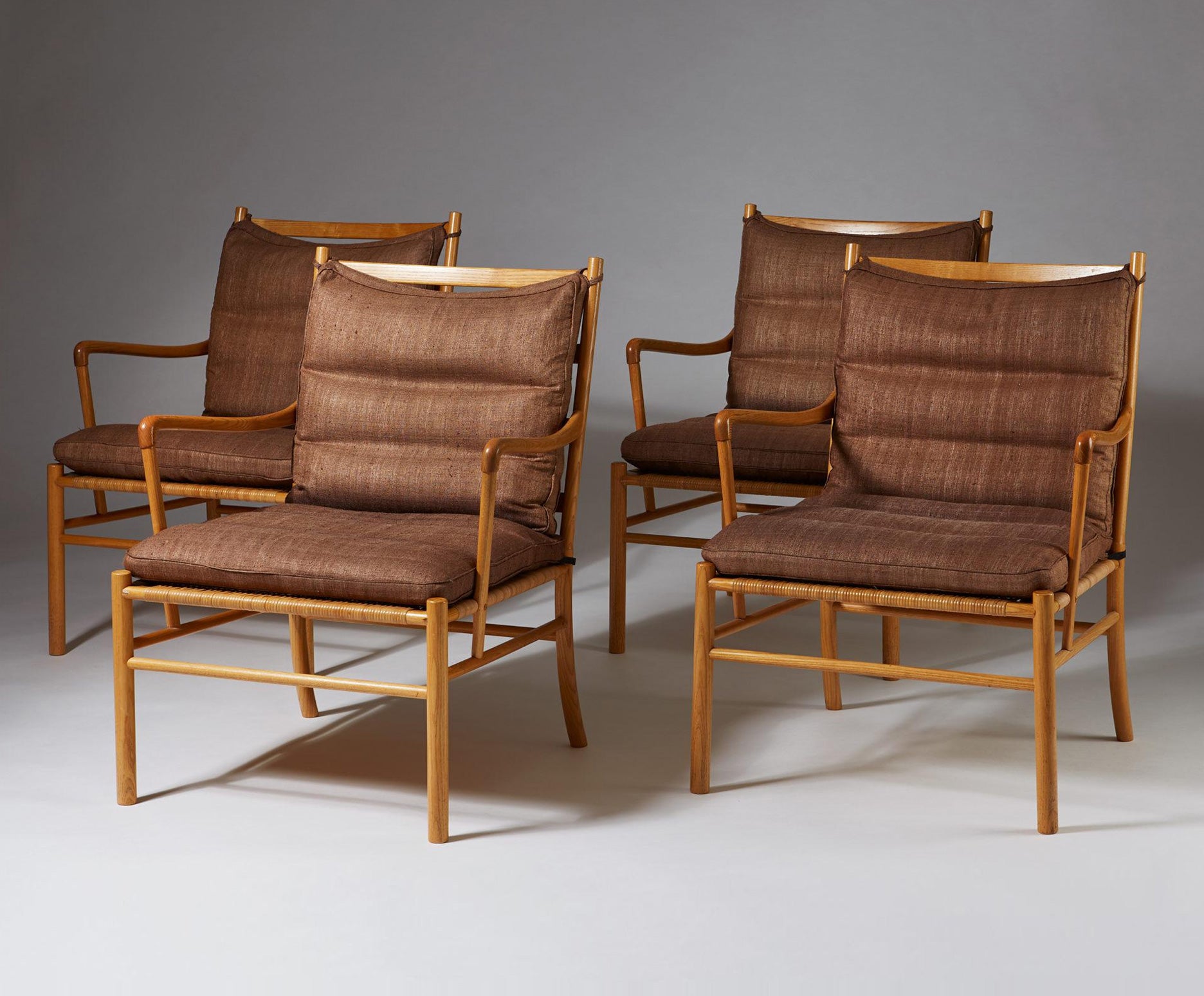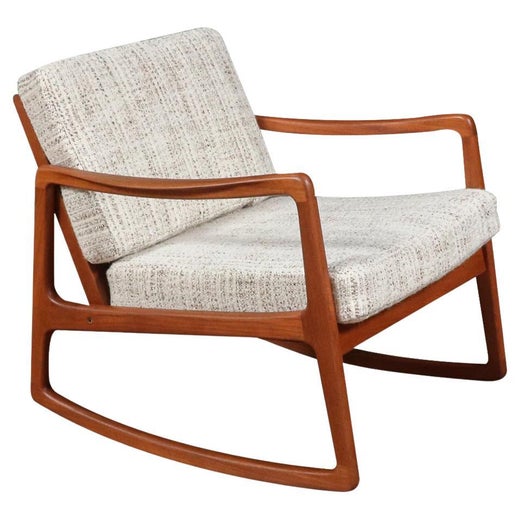Danish Teak Easy Chair by Ole Wanscher, 1950s
About the Item
- Creator:Ole Wanscher (Artist),France & Søn (Cabinetmaker)
- Design:Colonial ChairColonial Series
- Dimensions:Height: 32.29 in (82 cm)Width: 29.14 in (74 cm)Depth: 25.2 in (64 cm)Seat Height: 16.54 in (42 cm)
- Style:Scandinavian Modern (Of the Period)
- Materials and Techniques:
- Place of Origin:
- Period:
- Date of Manufacture:1950
- Condition:Refinished. Wear consistent with age and use. Frame was cleaned & refreshed.
- Seller Location:St-Brais, CH
- Reference Number:1stDibs: LU7132231091492
Colonial Chair
In creating his seminal work, the Colonial chair, in 1949, Danish designer Ole Wanscher (1903–85) found the ideal balance between minimalism and traditionalism through a simple silhouette, slim wooden framework and plush leather cushions. While Wanscher may not be a household name today in the way that his Danish contemporaries Arne Jacobsen, Finn Juhl and Hans Wegner are, he played a prominent role in mid-century Scandinavian design and is greatly respected by furniture historians.
Raised by an art historian father, Wanscher developed an appreciation for the arts at an early age, eventually going on to study architecture and furniture design under modernist master Kaare Klint at the Royal Danish Academy of Fine Arts. After graduating, he worked for Klint’s practice before starting his own firm. Then, after Klint’s death in 1954, Wanscher took over Klint’s academic role until his own retirement from the academy in 1973. His professional accolades include the Copenhagen Carpenters’ Guild Annual Award and the gold medal at the 1960 Milan Triennale.
An avid historian himself, Wanscher also traveled the world to study designs from different cultures and was particularly interested in furniture from Egypt, Greece and China, as well as from the Shaker movement and the Vienna Secession. He’d later publish the results of his global studies in The Art of Furniture: 5,000 Years of Furniture and Interiors. This approach, rooted in history, which was largely inspired by Klint’s own philosophy, set Wanscher apart from the segment of Scandinavian modernists who eschewed the past for the present and the future.
For the Colonial chair, Wanscher drew inspiration from 18th-century English furniture, namely ladder-backed chairs by Thomas Chippendale. He crafted the slim frame of roundwood timber, using curved armrests and legs — a Wanscher signature element — and thoughtfully placed mortise-and-tenon joints to create stability. And although the finished product radiates a sense of careful craftsmanship, Wanscher designed the Colonial chair to be easily manufactured: Its wood frame, woven cane seat and leather cushions can each be produced separately and joined at a later stage.
The Colonial chair was originally manufactured by P. Jeppesens Møbelfabrik, for whom Wanscher also designed the Colonial sofa and the Colonial coffee table to complete the Colonial collection. Today the chair is manufactured by Carl Hansen & Søn and sold alongside a footrest. It remains a crowd-pleaser with its timeless, elegant yet simple form.
France & Søn
Danish manufacturer France & Søn is best known for its prolific output of elegant mid-century modern furnishings in teak and leather, yet its multinational beginnings took shape during the 1930s.
After businessman Charles William Fearnley France (1897–1972) moved from his native England to Denmark in 1936, he began to operate a small mattress factory alongside his friend Eric Daverkosen, a Danish cabinetmaker, under the name France & Daverkosen. Shortly afterward, Daverkosen passed away, and when Denmark was invaded during the Second World War, Charles was captured and sent to a prison camp in Germany. When he was released, the British entrepreneur set out to produce furniture in the early 1950s, setting up a shop in Hillerød to manufacture the kind of sleek beech and teak goods that were gaining widespread acclaim around the world. In 1957, France’s son James joined the business, and the company changed its name to reflect the addition.
Throughout the ’50s and ’60s, France & Søn produced a stunning array — and staggering quantity — of designs, with elegant modernist lounge chairs and armchairs, teak and rosewood dining tables and other furnishings by the likes of Finn Juhl, Grete Valk, Ole Wanscher, Peter Hvidt and Orla Mølgaard-Nielsen all gracing its catalogues.
Even as there was a focus on mass production at France & Søn — and the brand doesn’t quite enjoy the same renown as fellow mid-century Danish furniture makers such as Carl Hansen & Søn — Charles France believed in making quality furniture, and the company’s offerings evoke the warmth of the handcrafted work that is typically associated with Scandinavian modernism.
In the 1960s, the company was bought by Danish designer Poul Cadovius, who folded it into the operations at CADO, a company he founded during the 1950s. Surviving examples of early work from the brand as well as modern icons by the likes of Verner Panton that followed in later years continue to be in demand.
Find a collection of France & Søn furniture on 1stDibs.
You May Also Like
Vintage 1960s Danish Mid-Century Modern Lounge Chairs
Fabric, Wool, Teak
Vintage 1950s Danish Scandinavian Modern Lounge Chairs
Leather, Wool, Beech
Vintage 1950s Danish Scandinavian Modern Armchairs
Leather, Mahogany
Vintage 1950s Danish Scandinavian Modern Armchairs
Leather, Mahogany
Vintage 1960s Danish Mid-Century Modern Lounge Chairs
Wool, Teak, Fabric
Vintage 1950s Danish Scandinavian Modern Lounge Chairs
Leather, Rosewood
Vintage 1950s Danish Scandinavian Modern Lounge Chairs
Leather, Rosewood
Vintage 1950s Danish Scandinavian Modern Lounge Chairs
Leather, Walnut
Vintage 1960s Danish Scandinavian Modern Lounge Chairs
Teak, Leather
20th Century Danish Scandinavian Modern Armchairs
Leather, Mahogany

